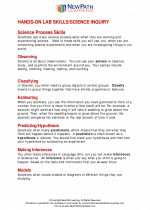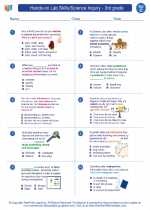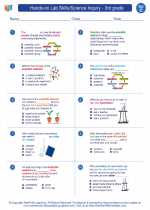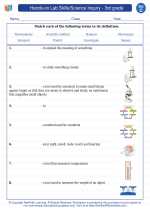Newton's First Law of Motion
Newton's first law of motion, also known as the law of inertia, states that an object at rest will stay at rest, and an object in motion will stay in motion at a constant velocity, unless acted upon by an external force.
Key Concepts:
- Inertia: Inertia is the tendency of an object to resist changes in its state of motion. An object will not change its velocity unless a force acts upon it.
- Equilibrium: When the net force acting on an object is zero, it is in a state of equilibrium. This means that the object will either remain at rest or continue to move at a constant velocity.
Examples:
Here are a few examples that illustrate Newton's first law:
- An ice hockey puck will continue to slide across the ice with constant velocity unless a force, such as friction, acts to slow it down.
- A book sitting on a table will not move unless a force is applied to push or pull it.
- A car will continue moving forward at a constant speed unless the brakes are applied to slow it down.
Study Guide:
Here are some key points to remember about Newton's first law:
- Objects at rest stay at rest, and objects in motion stay in motion with the same speed and in the same direction unless acted upon by an unbalanced force.
- Inertia is the tendency of an object to resist changes in its state of motion.
- An object in equilibrium has a net force of zero acting on it.
It's important to understand and recognize examples of inertia and equilibrium to fully grasp Newton's first law of motion.
.◂Science Worksheets and Study Guides Third Grade. Hands-on Lab Skills/Science Inquiry - 3rd grade
Study Guide Hands-on Lab Skills/Science Inquiry - 3rd grade
Hands-on Lab Skills/Science Inquiry - 3rd grade  Worksheet/Answer key
Worksheet/Answer key Hands-on Lab Skills/Science Inquiry - 3rd grade
Hands-on Lab Skills/Science Inquiry - 3rd grade  Worksheet/Answer key
Worksheet/Answer key Hands-on Lab Skills/Science Inquiry - 3rd grade
Hands-on Lab Skills/Science Inquiry - 3rd grade  Worksheet/Answer key
Worksheet/Answer key Hands-on Lab Skills/Science Inquiry - 3rd grade
Hands-on Lab Skills/Science Inquiry - 3rd grade  Worksheet/Answer key
Worksheet/Answer key O-W-L
O-W-L  Vocabulary/Answer key
Vocabulary/Answer key Hands-on Lab Skills/Science Inquiry - 3rd grade
Hands-on Lab Skills/Science Inquiry - 3rd grade  Vocabulary/Answer key
Vocabulary/Answer key Hands-on Lab Skills/Science Inquiry - 3rd grade
Hands-on Lab Skills/Science Inquiry - 3rd grade 

 Worksheet/Answer key
Worksheet/Answer key
 Worksheet/Answer key
Worksheet/Answer key
 Worksheet/Answer key
Worksheet/Answer key
 Worksheet/Answer key
Worksheet/Answer key
 Vocabulary/Answer key
Vocabulary/Answer key
 Vocabulary/Answer key
Vocabulary/Answer key

The resources above cover the following skills:
Science as Inquiry and Process: A student should understand and be able to apply the processes and applications of scientific inquiry. A student who meets the content standard should:
Develop an understanding of the processes of science used to investigate problems, design and conduct repeatable scientific investigations, and defend scientific arguments.